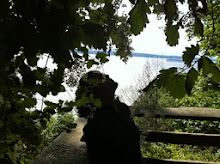
(View some more of her work at National Galleries of Scotland)
If you want experience and understanding of beauty envy me now but if you want happiness then don’t envy me because these things don’t bring happiness - Joan Eardley (1921-1963)
Who was Joan Eardley? Even the introduction to the book accompanying the exhibition Joan Eardley held at the National Gallery Complex, Edinburgh, begins with these words. A woman, a painter born in England living in Scotland, a social realist, Scotland’s answer to the Cobra artists or Jackson Pollock and Willem de Kooning. Where does she stand? As part of the London Kitchen Sink School or as an exponent of pure abstraction. Ah well! Let others well versed in the nuances of painting pare though this bewildering heap of categorization. For us it’s just another Sunday afternoon at the Tate Modern Bookshop. So lets simply indulge in the pure joy of her art.
Lets start with the children. Immensely engaging portraits of children residing in the poorest tenements of post Second World War Glasgow. Like sublime photographs discovered among old family papers. Look at their eyes, their expressions, their fragile beauty as they lean against graffiti scrawled walls and windows of derelict apartments. Look these are two friends. Look at this one’s right arm around the other’s shoulder, look at the other one holding her fingers, look at their smiling eyes. Look here are three children leaning out of the window with the two little ones covering their mouth with their hands. Here are Pat and Anne Samson with astonishingly distinct personalities for one so young vividly portrayed with chalk on paper. This little girl with a squint sucking her fingers lost in deep thought. What is she thinking? These children at play in the back street and these standing in queue for the Saturday Matinee. And look here is Andrew reading a comic. How did his life turn out? With a few brush strokes the life and times of an entire generation gets captured and reproduced here in these 96 pages.
Of course there is more. The shores of Catterline with the raging waves and the sky barely hanging in and one can almost feel the wind sculpt and transform the entire scene. Fields with birds, fields with daisies, fields at harvest time and something almost always giving away the presence of the wind. And the Sleeping Nude, which “was subjected to ‘shock horror’ headlines in tabloid press. One newspaper published her address, whereupon various men turned up volunteering to pose for her. Eardley never again painted a male nude.” The city councilors too weren’t keen on her depiction of the tenements in a rapidly modernizing Glasgow. In the last year of her life Eardley began painting flower studies.
There are also photographs by Eardley and others documenting life in Glasgow. And of Eardley herself. As a young girl, with her sister and a piglet, in Italy, at Catterline, on her motor scooter, in her studio. Joan Eardley who died aged just forty-two with the contents of her house at Catterline valued “…just 25 pounds, the paintings in the studio were valued at 1000 pounds...total sum of her estate was 19,881 pounds.”
There is enough in these pages about how she lived, painted and died to answer the original question. But as you turn the last page you know her art is answer enough, but now other questions all starting with ‘why’ suddenly appear to be more pertinent.


















No comments:
Post a Comment